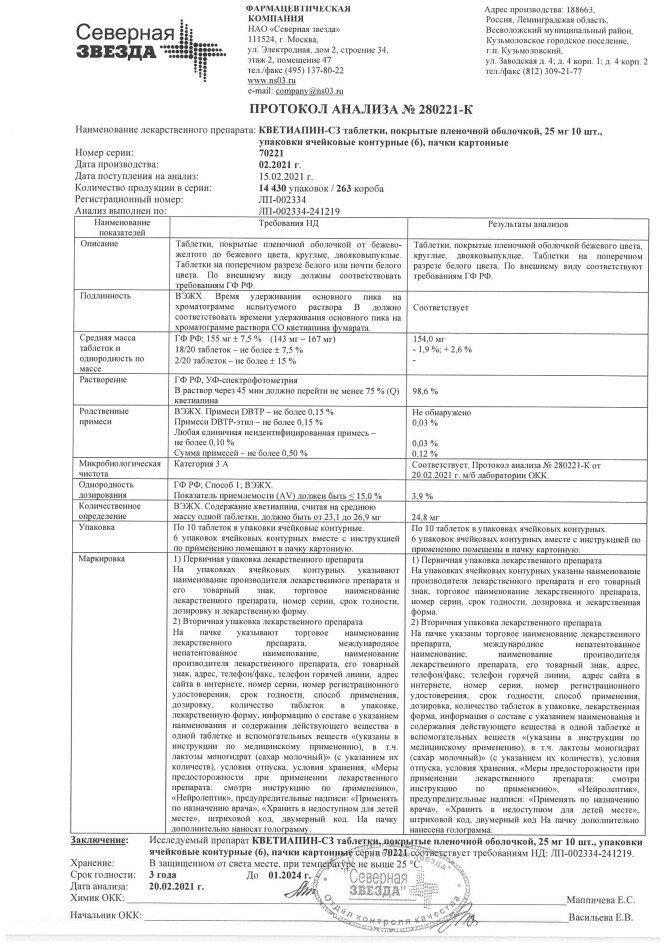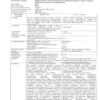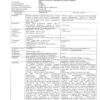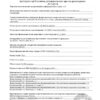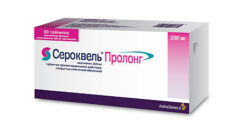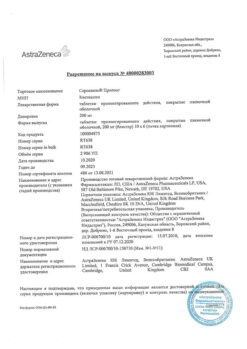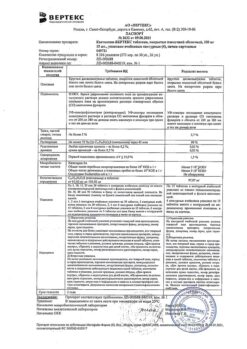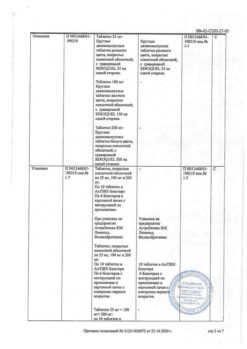No products in the cart.
Quetiapine, 25 mg 60 pcs
€9.92 €8.68
Out of stock
(E-mail when Stock is available)
Description
– Treatment of schizophrenia.
Indications
Indications
– Treatment of schizophrenia.
– Treatment of manic episodes in the structure of bipolar disorder.
– Treatment of depressive episodes of moderate to severe severity in the structure of bipolar disorder.
The drug is not indicated for the prevention of manic and depressive episodes.
Pharmacological effect
Pharmacological effect
Pharmacotherapeutic group of the drug: antipsychotic (neuroleptic)
Special instructions
Special instructions
Drowsiness
During therapy with Quetiapine, drowsiness and associated symptoms, such as sedation, may occur (see section “Side effects”). In clinical studies involving patients with depression as part of bipolar disorder, somnolence typically developed during the first three days of therapy.
The severity of this side effect was generally minor or moderate. If severe sleepiness develops, patients with depression as part of bipolar disorder may require more frequent visits to the doctor for 2 weeks after the onset of sleepiness or until symptoms improve. In some cases, discontinuation of quetiapine therapy may be necessary.
Patients with cardiovascular diseases
Caution should be exercised when prescribing Quetiapine to patients with cardiovascular and cerebrovascular diseases, and other conditions predisposing to hypotension. During therapy with Quetiapine, orthostatic hypotension may occur, especially during dose titration at the beginning of therapy. If orthostatic hypotension occurs, dose reduction or slower titration may be necessary.
Seizures
There were no differences in the incidence of seizures in patients taking quetiapine or placebo. However, as with other antipsychotic drugs, caution is recommended when treating patients with a history of seizures (see section “Side effects”).
Extrapyramidal symptoms
There was an increase in the incidence of EPS in adult patients with depression in the structure of bipolar disorder when taking Quetiapine for depressive episodes compared to placebo (see section “Side effects”).
Tardive dyskinesia
If symptoms of tardive dyskinesia develop, it is recommended to reduce the dose of the drug or gradually discontinue it (see section “Side effects”). Neuroleptic malignant syndrome
While taking antipsychotic drugs, including Quetiapine, neuroleptic malignant syndrome may develop (see section “Side Effects”). Clinical manifestations of the syndrome include hyperthermia, altered mental status, muscle rigidity, lability of the autonomic nervous system, and increased creatine phosphokinase activity. In such cases, it is necessary to discontinue Quetiapine and carry out appropriate treatment.
Pronounced neutronia
In clinical studies of Quetiapine, cases of severe neutropenia (neutrophil count
Interaction with other drugs
Also see the section “Interactions with other drugs”. The use of Quetiapine in combination with strong inducers of the liver enzyme system, such as carbamazepine and phenytoin, helps to reduce the concentration of quetiapine in plasma and may reduce the effectiveness of Quetiapine therapy. Prescribing Quetiapine to patients receiving liver enzyme inducers is possible only if the expected benefit from Quetiapine therapy outweighs the risk associated with discontinuation of the liver enzyme inducer drug. Changing the dose of drugs that induce microsomal enzymes should be gradual. If necessary, they can be replaced with drugs that do not induce microsomal enzymes (for example, valproic acid drugs).
Hyperglycemia
While taking quetiapine, hyperglycemia or exacerbation of diabetes mellitus may develop in patients with a history of diabetes mellitus. Clinical monitoring of patients with diabetes mellitus and patients with risk factors for developing diabetes mellitus is recommended (see section “Side effects”). Lipid levels
While taking quetiapine, the concentration of triglycerides and cholesterol may increase (see section “Side effects”).
QT prolongation
There was no relationship between taking quetiapine and a persistent increase in the absolute value of the QT interval. However, prolongation of the QT interval was observed with an overdose of the drug (see section “Overdose”). Caution should be exercised when prescribing quetiapine, as with other antipsychotic drugs, to patients with cardiovascular disease and a history of QT prolongation. It is also necessary to be careful when prescribing quetiapine simultaneously with drugs that prolong the QTc interval, other antipsychotics, especially in the elderly, patients with congenital long QT syndrome, chronic heart failure, myocardial hypertrophy, hypokalemia or hypomagnesemia (see section “Interaction with other drugs”).
Acute reactions associated with drug withdrawal
If quetiapine is abruptly discontinued, the following acute reactions (withdrawal syndrome) may occur: nausea, vomiting, insomnia, headache, dizziness and irritability. Therefore, it is recommended to discontinue the drug gradually over at least one or two weeks.
Elderly patients with dementia
Quetiapine is not indicated for the treatment of psychoses associated with dementia. Some atypical antipsychotics in randomized placebo-controlled trials increased the risk of cerebrovascular events in patients with dementia by approximately 3-fold. The mechanism for this increased risk has not been studied. A similar risk of increased incidence of cerebrovascular complications cannot be excluded for other antipsychotic drugs or other patient groups. Quetiapine should be used with caution in patients at risk of stroke.
An analysis of the use of atypical antipsychotics for the treatment of psychosis associated with dementia in elderly patients revealed an increased mortality rate in the group of patients receiving drugs of this group compared with the placebo group. In addition, two 10-week placebo-controlled studies of quetiapine in a similar group of patients (n = 710; mean age: 83 years; age range: 56-99 years) showed that the mortality rate in the group of patients taking quetiapine was 5.5%, and 3.2% in the placebo group.
The causes of death observed in these patients were consistent with those expected for this population. No causal relationship has been identified between treatment with Quetiapine and the risk of increased mortality in elderly patients with dementia.
Suicide/suicidal ideation or clinical worsening
Depression is associated with an increased risk of suicidal ideation, self-harm and suicide (suicide-related events). This risk persists until significant remission occurs. Because it may take several weeks or more for the patient’s condition to improve from the start of treatment, patients should be under close medical supervision until improvement occurs.
According to generally accepted clinical experience, the risk of suicide may increase in the early stages of remission.
Other mental disorders for which quetiapine is prescribed are also associated with an increased risk of suicide-related events. In addition, such conditions may be comorbid with a depressive episode. Thus, the precautions used when treating patients with a depressive episode should also be taken when treating patients with other mental disorders.
Patients with a history of suicidal events, as well as patients who clearly express suicidal thoughts before starting therapy, are at increased risk of suicidal intent and suicide attempts and should be carefully monitored during treatment.
An FDA meta-analysis of placebo-controlled studies of antidepressants, summing up data from approximately 4,400 children and adolescents and 7,700 adult patients with mental disorders, found an increased risk of suicidal behavior with antidepressants compared with placebo in children, adolescents and adult patients under 25 years of age.
This meta-analysis does not include studies where quetiapine was used (see Pharmacodynamics section). In short-term, placebo-controlled studies across all indications and in all age groups, the incidence of suicide events was 0.9% for both quetiapine (61/6270) and placebo (27/3047). In these studies in patients with schizophrenia, the risk of suicide-related events was 1.4% (3/212) for quetiapine and 1.6% (1/62) for placebo in patients aged 18–24 years; 0.8% (13/1663) for quetiapine and 1.1% (5/463) for placebo in patients over 25 years of age; 1.4% (2/147) for quetiapine and 1.3% (1/75) for placebo in patients under 18 years of age.
In patients with manic bipolar disorder, the risk of suicide-related events was 0% (0/67) for quetiapine and 0% (1/57) for placebo in patients aged 18–24 years; 1.2% (6/496) for quetiapine and 1.2% (6/503) for placebo in patients over 25 years of age; 1.0% (2/193) for quetiapine and 0% (0/90) for placebo in patients under 18 years of age (see section “Special Instructions”).
In patients with depressed bipolar disorder, the risk of suicide-related events was 3.0% (7/233) for quetiapine and 0% (0/120) for placebo in patients aged 18–24 years; 1.8% (19/1616) for quetiapine and 1.8% (11/622) for placebo in patients over 25 years of age. No studies have been conducted in patients with depression due to bipolar disorder under the age of 18 years.
Impact on the ability to drive vehicles and operate machinery
Quetiapine may cause drowsiness, therefore, during treatment, patients are not recommended to work with dangerous mechanisms, including driving.
Active ingredient
Active ingredient
Quetiapine
Composition
Composition
1 tablet contains:
active ingredient: quetiapine fumarate, in terms of quetiapine – 25 mg;
excipients (core):
microcrystalline cellulose – 60.0 mg;
lactose monohydrate (milk sugar) – 44.0 mg;
povidone (medium molecular weight polyvinylpyrrolidone) – 9.0 mg;
croscarmellose sodium (primellose) – 10.5 mg;
magnesium stearate – 1.5 mg;
excipients (shell): Opadry II (polyvinyl alcohol, partially hydrolyzed – 2.0 mg; macrogol (polyethylene glycol) 3350 – 1.01 mg; talc – 0.74 mg; titanium dioxide E 171 – 1.1333 mg; iron dye oxide (II) yellow E 172 – 0.1167 mg).
Contraindications
Contraindications
Hypersensitivity to any of the components of the drug, including lactase deficiency, glucose-galactose malabsorption and galactose intolerance. Combined use with cytochrome P450 inhibitors, such as azole antifungals, erythromycin, clarithromycin and nefazodone, as well as protease inhibitors (see section “Interaction with other drugs”).
Although the effectiveness and safety of Quetiapine in children and adolescents aged 10-17 years have been studied in clinical studies, the use of Quetiapine in patients under the age of 18 years is not indicated.
With caution
In patients with cardiovascular and cerebrovascular diseases or other conditions predisposing to arterial hypotension, advanced age, liver failure, or a history of seizures.
Side Effects
Side Effects
From the central nervous system: headache, drowsiness, dizziness, anxiety; rarely – ZNS.
From the cardiovascular system: orthostatic hypotension, tachycardia, arterial hypertension.
From the digestive system: constipation, dry mouth, dyspepsia, diarrhea, transient increase in the activity of liver enzymes (ALT, AST, GGT), abdominal pain.
From the hematopoietic organs: asymptomatic leukopenia and/or neutropenia; rarely – eosinophilia.
From the musculoskeletal system: myalgia.
From the respiratory system: rhinitis.
Dermatological reactions: skin rash, dry skin.
From the organ of hearing: pain in the ear.
From the genitourinary system: urinary tract infections.
On the metabolic side: a slight increase in cholesterol and triglycerides in the blood.
From the endocrine system: a small dose-dependent reversible decrease in the level of thyroid hormones (in particular total and free T4).
Other: asthenia, lower back pain, weight gain, fever, chest pain.
Interaction
Interaction
Caution should be exercised when using Quetiapine in combination with other drugs that affect the central nervous system, as well as with alcohol. The cytochrome P450 isoenzyme (CYP) 3A4 is the main isoenzyme responsible for the metabolism of quetiapine, which is carried out through the cytochrome P450 system.
When studied in healthy volunteers, coadministration of quetiapine (25 mg) with ketoconazole, a CYP3A4 inhibitor, resulted in a 5- to 8-fold increase in the area under the concentration-time curve (AUC) of quetiapine. Therefore, co-administration of quetiapine and cytochrome CYP3A4 inhibitors is contraindicated.
It is also not recommended to take quetiapine with grapefruit juice. In a pharmacokinetic study, administration of quetiapine at various dosages before or concomitantly with carbamazepine resulted in a significant increase in quetiapine clearance and, accordingly, a decrease in AUC by an average of 13% compared with quetiapine without carbamazepine. In some patients, the decrease in AUC was even more pronounced.
This interaction is accompanied by a decrease in plasma concentrations of quetiapine and may reduce the effectiveness of quetiapine therapy. Co-administration of Quetiapine with phenytoin, another inducer of the liver microsomal system, was accompanied by an even more pronounced (approximately 450%) increase in the clearance of quetiapine.
Prescribing Quetiapine to patients receiving liver enzyme inducers is possible only if the expected benefit from Quetiapine therapy outweighs the risk associated with discontinuation of the liver enzyme inducer drug. Changing the dose of drugs that induce microsomal enzymes should be gradual.
If necessary, they can be replaced with drugs that do not induce microsomal enzymes (for example, valproic acid drugs). The pharmacokinetics of quetiapine did not change significantly when co-administered with the antidepressant imipramine (CYP2D6 inhibitor) or fluoxetine (CYPZA4 and CYP2D6 inhibitor).
The pharmacokinetics of quetiapine does not change significantly when administered concomitantly with the antipsychotic drugs risperidone or haloperidol. However, simultaneous administration of quetiapine and thioridazine resulted in an increase in quetiapine clearance by approximately 70%. The pharmacokinetics of quetiapine does not change significantly with simultaneous use of cimetidine.
With a single dose of 2 mg of lorazepam while taking quetiapine at a dose of 250 mg 2 times a day, the clearance of lorazepam is reduced by approximately 20%. The pharmacokinetics of lithium preparations does not change with the simultaneous administration of Quetiapine. There were no clinically significant changes in the pharmacokinetics of valproic acid and quetiapine when co-administered with semisodium valproate and quetiapine.
Pharmacokinetic studies examining the interaction of Quetiapine with drugs used for cardiovascular diseases have not been conducted. Caution should be exercised when using Quetiapine in combination with drugs that can cause electrolyte imbalance and prolongation of the QTc interval. Quetiapine did not cause induction of hepatic enzyme systems involved in the metabolism of phenazone.
Overdose
Overdose
A death was reported with 13.6 g of quetiapine in a patient participating in a clinical trial, and a death was reported with 6 g of quetiapine in a post-marketing study. At the same time, a case was described of taking quetiapine in a dose exceeding 30 g without death.
There are reports of extremely rare cases of quetiapine overdose, leading to an increase in the QTc interval, death or coma. In patients with a history of severe cardiovascular disease, the risk of side effects from overdose may increase (see section “Special Instructions”).
Symptoms noted in overdose were mainly due to an increase in the known pharmacological effects of the drug, such as drowsiness and sedation, tachycardia and decreased blood pressure. There are no specific antidotes to quetiapine. In cases of serious intoxication, be aware of the possibility of overdosing on multiple medications.
It is recommended to take measures aimed at maintaining respiratory and cardiovascular function, ensuring adequate oxygenation and ventilation. Gastric lavage (after intubation if the patient is unconscious) and administration of activated charcoal and laxatives may help eliminate unabsorbed quetiapine, but the effectiveness of these measures has not been studied.
Close medical observation should continue until the patient’s condition improves.
Storage conditions
Storage conditions
In a dry place, protected from light, at a temperature not exceeding 25 oC.
Keep out of the reach of children.
Shelf life
Shelf life
3 years. Do not use after the expiration date stated on the package.
Manufacturer
Manufacturer
North Star NAO, Russia
Additional information
| Shelf life | 3 years. |
|---|---|
| Conditions of storage | In a dry, light-protected place at a temperature not exceeding 25 oC. |
| Manufacturer | North Star NAO, Russia |
| Medication form | pills |
| Brand | North Star NAO |
Other forms…
Related products
Buy Quetiapine, 25 mg 60 pcs with delivery to USA, UK, Europe and over 120 other countries.


